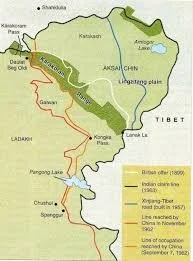Introduction
India and China share a border of 3500 km running from Kashmir to Myanmar and at most places it is not clearly delineated and is called the Line of Actual Control (LAC).
The term ‘LAC’ gained legal recognition after the Sino-India border agreements signed in 1993 and in 1996. The 1996 agreement states that no activity shall overstep the Line of Actual Control. In the previous few weeks, two places along the Indo-China border have emerged as hotspots, which are, Sikkim and Ladakh.
In Ladakh there are two contentious areas where Chinese army has increased its deployment of troops and war-like material, namely, Pangong Tso and Galwan valley. Meanwhile, Indian troops have resorted to aggressive patrolling in these areas and though no bullets have been fired there have been violent physical clashes between the troops using sticks and batons.
Situation in Galwan Valley
Chinese troops have entered Galwan valley and pitched tents, 3-4 km inside Indian Territory, which China claims to be there territory. Incidentally, Galwan valley was a flash point during the Sino-India conflict of 1962. China has been trying ever since to alter the LAC and occupy the Galwan valley.
The Galwan valley has a strategic significance for India. Last year India completed the Shyok-Daulat Beg Oldie road which serves as the lifeline for servicing troops deployed in Sub-Sector North close to the crucial Karakoram pass through which the China-Pakistan-Economic Corridor (CPEC) joins China with Pakistan via PoK.
The Galwan River flows from the disputed Aksai Chin region, which India’s claims as its own, to Xinjian region in China before entering Ladakh. China has built a stranglehold on a large part of the Galwan valley which includes a portion of Ladakh region.
Chinese presence in the Galwan valley threatens this important road that India has constructed. However, China claims that India has been doing “illegal” construction of defence facilities in this area which rightfully belongs to China.
China had objected to India’s decision to separate Ladakh from the ‘disputed’ State of J&K and declaring it a Union Territory in August 2019. Experts feel that China is preparing the ground for claiming this portion of Ladakh and make it into an international issue.
It is believed that nearly 5,000 to 10,000 soldiers of the People’s Liberation Army have been amassed in the ravine area with the military building makeshift arrangements for settling the troops and deployment of heavy military equipment and fighter aircrafts in its forward bases is being reported.
A high level security meet was chaired by PM Modi on 25th May to assess the situation. However, the frontier continues to remain tense.
History of Sino-India Military Stand-offs
China does not accept the Mc Mohan line as the legal delineation between India and China. It says that this was a demarcation agreed upon between erstwhile British Raj and Tibet.
In late 1967, there were two skirmishes between Indian and Chinese forces in Sikkim. The first one was dubbed the “Nathu La incident”, and the other the “Chola incident”, where exchange of heavy fire took place at the Sikkim outpost.
During the whole conflict Indian losses were 88 killed and 163 wounded, while Chinese casualties were 300 killed and 450 wounded in Nathu La, and 40 in Chola.
Once again, when India granted statehood to Arunachal Pradesh (formerly the North-East Frontier Agency) in February 1987, there was an escalation on the border, resulting in both sides to deploy additional troops in the area, raising tensions and fears of a new border war.
However, by the summer of 1987, both sides backed away from the conflict zone.
China formally recognized Sikkim as an Indian state in 2003, on the condition that India accepted Tibet Autonomous Region as a part of China. This mutual agreement led to closer Sino-Indian ties, including trade and commerce.
The Daulat Beg Oldi Incident May 2013: A three-week standoff between Indian and Chinese troops took place along the Line of Actual Control, 30 km south east of Daulat Beg Oldi in Ladakh region and Aksai Chin.
The matter was finally defused on 05 May 2013. India agreed to destroy some military structures along 250 km stretch near Chumar, which Chinese perceived to be threatening.
Later, in October 2013 both sides signed a Border Defence Cooperation Agreement to ensure that border patrolling does not escalate into a military conflict.
The Chumar Incident September 2014: Chumar is an area 300km northeast of Leh, bordering Himachal Pradesh. China has since long been trying to reduce India’s dominance in the area.
In the said incident, China commenced construction work of a road, which, as per the border understanding of 2005, should have only started after prior intimation to India.
Indian troops rushed to the site to stop the construction work. Meanwhile, China also called for reinforcement and eventually 1000 strong Chinese force was mobilised that sat 5 km into India territory in eye ball to eye ball contact with Indian troops.
The tension was eventually defused by mediation at the highest level.
The Demchuk Incident: Demchuk is the area where LAC ends and IB starts and also the area where Indus River enters into India from China.
The Demchuk incident was considered to be a diversionary ploy played by China, in which it objected to the construction of an irrigation canal by India at Demchuk, about 80 kms from the above stated Chumar site of confrontation.
They dispatched dozens of civilians and nomads to object, and who pitched tents on the Indian side of the LAC. So, it was more of an impasse between the local civilians of both sides of the LAC.
The Doklam Incident in Sikkim in June 2017: Chinese troops entered into Indian Territory in the Sikkim sector and jostled with Indian Army personnel guarding the Sino-India frontier, besides destroying two bunkers.
The Indian troops formed a human wall against the Chinese personnel to prevent them from advancing further into the Indian Territory. The incident was also video-graphed by some of them, the clipping of which has gone viral on the social media.
China, on the contrary claimed that Indian troops had violated the border and transgressed into its territory.
Consequently, China closed the cross-border Nathu La mountain pass, which China and India had re-opened in 2006 and the closure of Nathu La pass automatically blocked the entry for Indian pilgrims travelling to Kailash Mansarovar.
Reasons for the Doklam Stand-off
The specific reason for the stand-off was India’s objection to China building a road in the Sikkim sector of the border. India alleged that the area in question was under its jurisdiction, while China claimed that the area belonged to China as per the 1890 Sino-British Treaty.
The Indian state of Sikkim is sandwiched between Bhutan to the East, Nepal to the West, and China to the North. The road construction by China in question was a stretch of road near the narrow tri-junction where Sikkim, Bhutan, and China meet.
Meanwhile, Bhutan which does not hold diplomatic ties with China asked China to immediately halt its road construction activity and restore the status quo.
Strategic Reason: The road in question was being built at a very close distance from India’s most vulnerable geographic choke point, the Siliguri corridor.
The Siliguri corridor forms a chicken’s neck and is the primary link between the North-eastern states and the rest of India. Capture of this strategic choke point can cut-off the complete North-eastern region in one stroke.
Hence, it was for this reason that India reacted aggressively to checkmate Chinese manoeuvre that threatened the integrity of the well established international border.
China’s Larger Strategic Objective
Incursions from China continue despite protests and meetings by India. The intrusions are well coordinated and show marked interest by the PLA in areas of military significance.
China has highly developed surface and air communication facilities all along the Tibetan Autonomous Region (TAR), especially, opposite Arunachal Pradesh and is in the process of preparing a dozen more airfields in Tibet.
Indian side on the other hand, is highly under developed with difficult terrain and therefore, builds up, movement and reinforcement of troops will be laborious and time consuming.
Assertive stance of China on the border is an indicator that it wants to stake its territorial claims and also dissuade India from building up infrastructure along the border.
Also, by slowly biting into pieces of Indian Territory through continuous intrusions, the Chinese are observing how India’s political leadership and its security forces react to such provocation.
The PLA is training for short and swift conflict preceded by a cyber-offensive. An offensive could involve the use of missiles, anti-satellite weapons, overwhelming firepower and control over the air space. The extent and scale of conflict would depend on Chinese motives and intent.
China’s larger strategy is to isolate India and keep it confined to the back waters of South Asia through its policy of establishing a ‘string of pearls’ by increasing its influence over all neighbours of India, like, Nepal, Sri Lanka, Myanmar, Bangladesh, Maldives, Bhutan and of course with its all-time ally Pakistan.
Measures that India Needs to Adopt against China’s Threat
India must vigorously pursue its ‘Act East Policy by engaging all SE Asian nations, who have clashing interests with China in the South China Sea.
Similarly, engaging with a heavy weight like Japan in trade and diplomatic ties will serve as an effective counter weight against China’s expansionism, especially, when Japan and China are at daggers drawn over their dispute to control Senkaku (Diaoyu) islands in the East China Sea.
Improvement of infrastructure, especially along the disputed sectors is extremely essential for swift deployment of troops during an exigency.
In order to improve facilities at all its air-bases strung around the length and breadth of the country and make them compatible with modern aircraft operations a project named MAFI (Modernisation of Airfield Infrastructure) is being implemented.
The newly commissioned 9.15-kilometer-long Dhola Sadiya Bridge across the Brahmaputra River, which is designed to carry the weight of 60-ton main battle tanks, connects Arunachal Pradesh with the North-eastern state of Assam has been built with the primary aim of strengthening India’s military prowess close to the disputed border with China.
The Indian Railways is also all set to go beyond Assam and cover the rest of the seven sisters by 2020.
Militarily, India needs to improve its force level along the LAC and NE border with China. Towards this end, a new Mountain Corps is being raised to meet this explicit requirement.
In order to appear more assertive and forceful in projecting its footprints, at the tactical level, renewed emphasis must be laid on patrolling and surveillance using satellites, unmanned aerial vehicles (UAVs) and battle field surveillance radars.
Deployment of strategic assets, keeping the threat perception in mind, will serve as a serious deterrent and ‘a threat in being’, e.g. deployment of Agni V.
Notwithstanding the above, and keeping our dependence on China for trade and commerce in mind, it may be prudent to keep the diplomatic channels with China also open and look to resolve the long outstanding border disputes amicably though meaningful dialogue.






